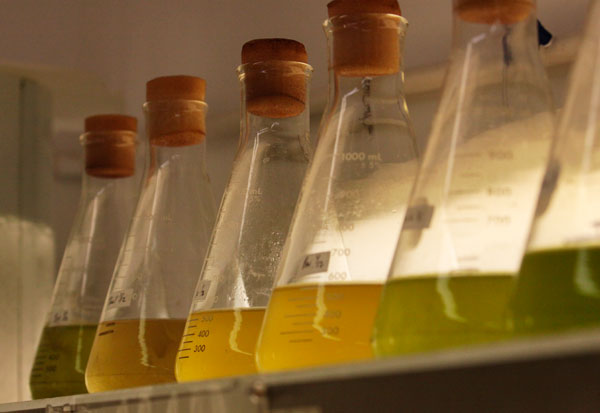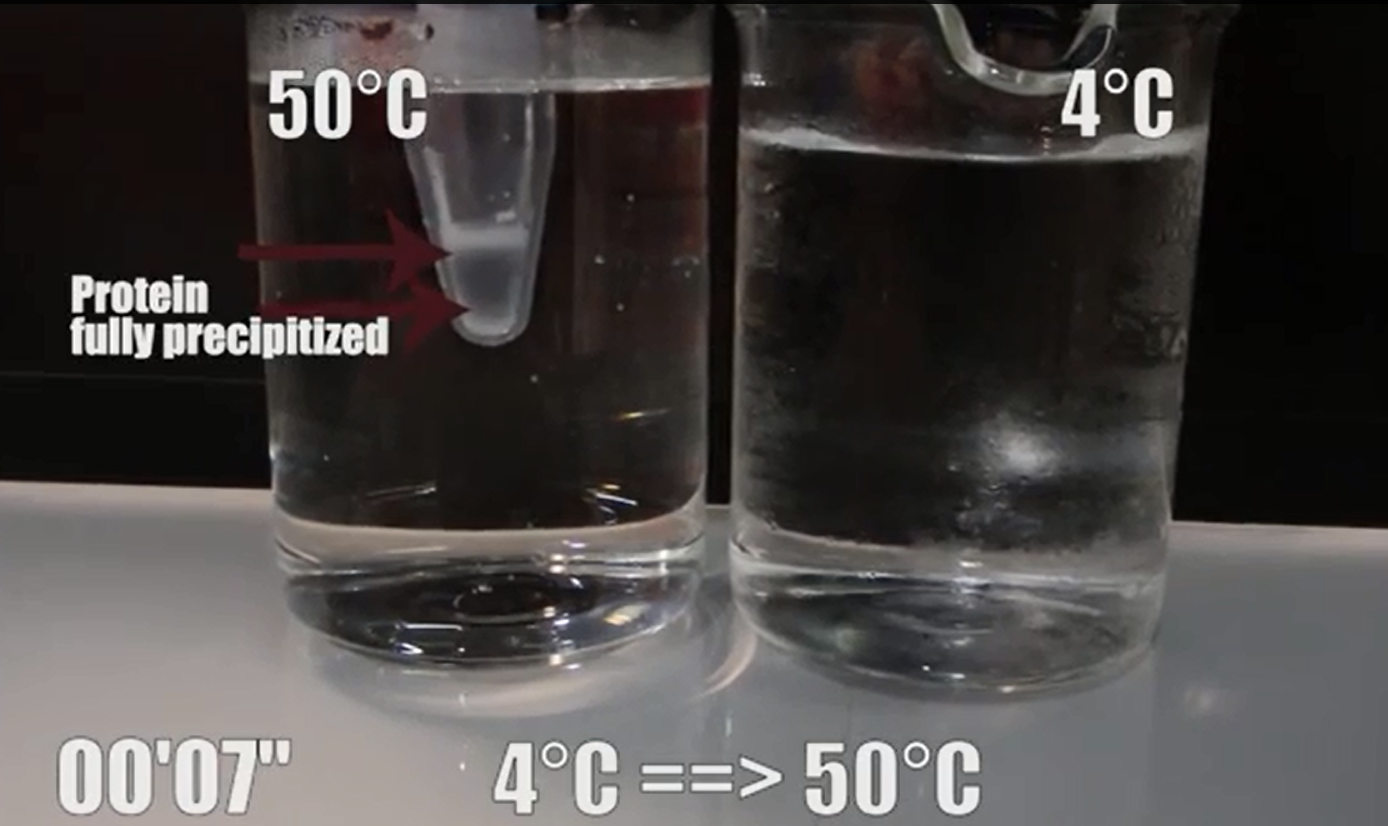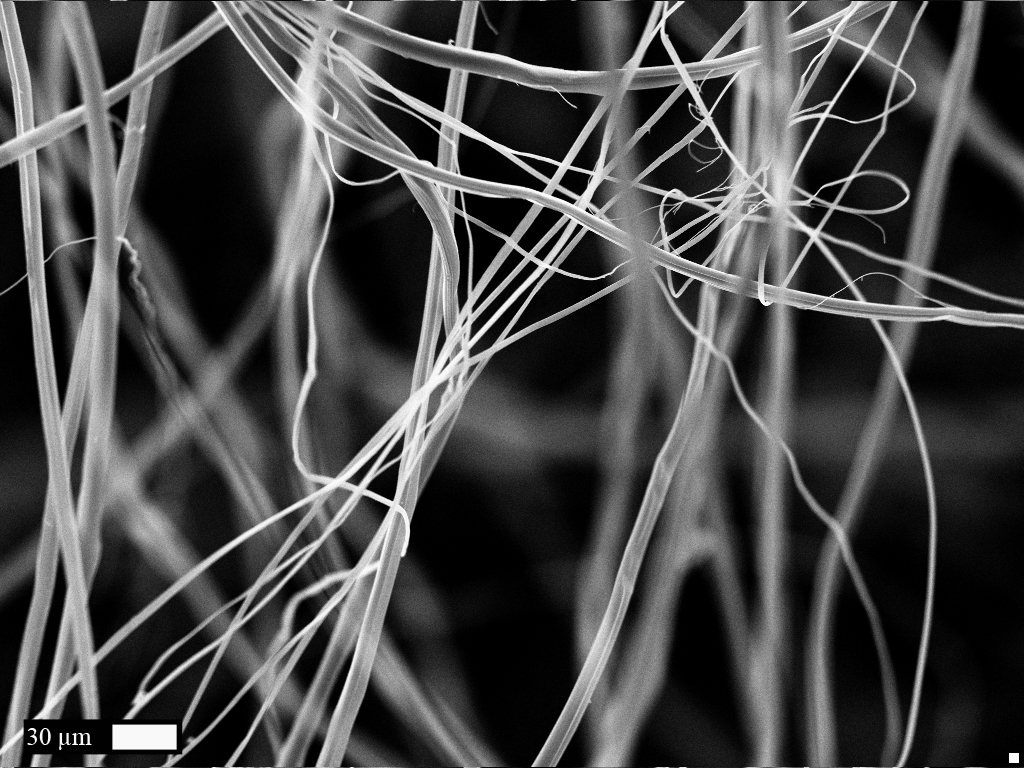|
|
| (18 intermediate revisions not shown) |
| Line 2: |
Line 2: |
| | | | |
| | | | |
| - | === Results obtained with the ELP biobrick (BBa_K1317003) ===
| + | [[file:Bdx2014 Production.jpg|left|400px]] [https://2014.igem.org/Team:Bordeaux/Results/Production Production (click for more info)]<br><br><br> We managed to settle the best conditions to produce the biopolymers in maximal amount. Different medium and production time were tested and a special BL21 strain was used.<br><br><br><br><br><br><br><br><br><br><br><br><br><br><br><br><br><br><br> |
| | + | ---- |
| | + | [[File:Bdx2014 Purification.jpg|left|400px]] [https://2014.igem.org/Team:Bordeaux/Results/Purification Purification (click for more info)]<br><br><br> The special properties of the ELP were used to purify the produced proteins by inverse thermal cycling (ITC), which is a quick, easy and column-free method for purification of this polymer <br><br><br><br><br><br><br><br><br><br><br><br><br><br><br><br><br><br><br> |
| | + | ---- |
| | + | [[File:Bdx2014 Characterization.jpg|left|400px]] [https://2014.igem.org/Team:Bordeaux/Results/Characterization Characterization (click for more info)]<br><br><br> Characterization was performed according to different physical and chemical methods. As the protein produced is a polymer, it was transformed into a fiber and its resistance and elasticity have been tested. <br><br><br><br><br><br><br><br><br><br><br><br><br><br><br><br><br><br><br> |
| | | | |
| - |
| |
| - | This part is made with a consensus of the natural elastin sequence. Elastin is a protein involved in maintaining shape and elasticity of several tissues like skin. It has a high elasticity and resilience as a polymer.
| |
| - |
| |
| - | In our project, the consensus sequence allows the use of a minimal pattern of the protein while keeping these particular properties. In an iGEM spirit the consensus itself can be used as a brick to vary length and nature of the polymers with our other biobricks ([http://parts.igem.org/Part:BBa_K1317001 BBa_K1317001], [http://parts.igem.org/Part:BBa_K1317002 BBa_K1317002]).
| |
| - |
| |
| - | The basic length of a polymer is 20 monomers. The coding sequence can be repeated easily using our improvement of the biobrick assembly system to get rid of the Stop Codon.
| |
| - | After variation of the length different properties are attributed to the part. For example it can be used as a fusion tag to purify easily any fuse protein thanks to the thermal cycling purification.
| |
| - |
| |
| - | ELP indeed have this particularity to solubilize at lower temperature. If it is used in a protein mixture (a lysate for example) after a few cycles of thermal cycling (from 4°C to 50°C), the pure fuse protein is obtained.
| |
| - |
| |
| - | This part can be used as a purification tag for easy, quick and column-free purification or as coding sequence for a polymer usable to get fiber with good elasticity and resilience.
| |
| - | The polymer is biocompatible, biodegradable and could be used as a tool for surgery or other health applications.
| |
| - |
| |
| - |
| |
| - | ===Usage and Biology===
| |
| - |
| |
| - |
| |
| - | =====Strain=====
| |
| - |
| |
| - | The protein ELP has been produced in BLR strain of ''E.coli'' (''F–ompT hsdSB(rB– mB–) gal dcm Δ(srl-recA)306::Tn10'')
| |
| - |
| |
| - | BLR is more suited for the production of ELP, it is a BL21 derivative in which plasmids containing repetitive sequences are stabilized.
| |
| - |
| |
| - |
| |
| - |
| |
| - |
| |
| - | <p>
| |
| - |
| |
| - | The protein ELP has been produced in BL21 strain of E.coli. After phase cycling purification it is possible to spin the protein into a wire, thanks to the wet-spinning method. The ELP can have different length regarding the number of copy of the gene. In these experiments, we used 40mer ELP (assemble of two gene copies).<br><br></p>
| |
| - | <p>
| |
| - | <b>Polymer formation trial:</b><br><br>
| |
| - |
| |
| - |
| |
| - | In order to obtain polymer wires, we carried out severeal tests by mixing the ELP with different solvants. The following results have been observed:<br><br>
| |
| - | Sodium Sulfate (Na2So4) at 320 g/L => cottony aspect of the fiber, the structure is not stable<br>
| |
| - | Diethyl ether (C2H5)2O => No reaction because the drop is trapped. This solvent is not miscible with the polymer
| |
| - | Acetone (CH3COCH3) => Formation of a white ring<br>
| |
| - | Heated Sodium Chloride (NaCl 5M) => Formation of a white cloud due to a lack of cohesiveness<br>
| |
| - | Calcium Chloride (CaCl2 15%) => 1.25% alginate mixture with ELP40 at 10mg/mL were extruded in the calcium chloride solution: a white-colored fiber is obtained.<br>
| |
| - | This last trial has been performed with 0.75% alginate which seems to be the best experimental condition to get fibers from the ELP<br><br>
| |
| - |
| |
| - | <img class="resultsmounir1" src="https://static.igem.org/mediawiki/parts/2/22/2014-10-07_20_25_40-iGEM_2014_-_Bordeaux.png" alt=""/><br><br>
| |
| - | <center>Fiber obtained by extruding ELP/Alginate in calcium chloride</center><br><br>
| |
| - | </p>
| |
| - |
| |
| - | <p>
| |
| - |
| |
| - | <b>Phase transition trial: </b><br><br>
| |
| - |
| |
| - | After getting the ELP40 fiber, it is necessary to wash it with hot water for extraction, the fiber could indeed dissolve at low temperature.<br>
| |
| - | - Control remains transparent<br>
| |
| - | - The aspect of the fiber changes at ambient temperature (from white to transparent)<br>
| |
| - | Thanks to the mixture alginate + ELP40 (10 mg/L), we could observe the formation of the polymer and it can be deduced that:<br>
| |
| - | - In presence of salt, product is losing cohesiveness<br>
| |
| - | - With contact of hot water, the product is contracting<br><br><br>
| |
| - |
| |
| - | <img class="resultsmounir2" src="https://static.igem.org/mediawiki/parts/e/e4/2014-10-07_21_43_49-Phase_transition.png" alt=""/><br><br>
| |
| - | <center>transition of the ELP according to temperature</center><br><br>
| |
| - |
| |
| - | </p>
| |
| - |
| |
| - |
| |
| - | <p>
| |
| - | You can see the results on the phase transition on this video: https://www.youtube.com/watch?v=xoTQkoNoZu0<br>
| |
| - | Wet-spinning and mechanical testing of fibers properties<br>
| |
| - | The wet-spinning method has been used to create a wire out of the polymer.<br><br>
| |
| - |
| |
| - | <img class="resultsmounir3" src="https://static.igem.org/mediawiki/parts/d/d4/TeamBdx2014_Wet_spin.gif" alt=""/><br><br>
| |
| - | <center>Overview of the wet-sinning method</center><br><br>
| |
| - | </p>
| |
| - | <p>
| |
| - |
| |
| - | A traction machine allows to measure the resistance to rupture of a chosen material, in this case, the fiber obtained by wet-spinning. This experiment consists in placing a little stick of the material to be studied between the jaws of the traction machine. It will pull the stick until its rupture. The lenghtening and the applied force are recorded and then converted into distorsion and pressure data.<br>
| |
| - | The mechanical testing allow us to state:<br>
| |
| - | For the alginate<br>
| |
| - | The experiment done with the alginate is reproducible while using the same conditions, but the fiber ends by breaking.<br>
| |
| - | Alginate breaks faster because the experiment is carried out at high temperature<br>
| |
| - | Comparison with carbon nanofibers<br>
| |
| - | The elasticity is comparable with carbon nanofibers. Thus, ELP has characteristic properties of elasticity due to its polymeric nature.<br>
| |
| - | The fibers are nevertheless fragile and break easily. Enhancing the resistance should be possible by using another part and fusing the proteins (BBa_K1317001, BBa_K1317002)<br>
| |
| - | Another trial was carried out with two times more alginate. The result seems to be the same, the fiber breaks fast.<br><br>
| |
| - |
| |
| - |
| |
| - |
| |
| - |
| |
| - |
| |
| - | <img class="resultsmounir4" src="https://static.igem.org/mediawiki/parts/f/fe/Bdx2014_Mechanical_traction_1.jpg" alt=""/><br><br>
| |
| - |
| |
| - | <center>The mechanical traction machine</center><br><br>
| |
| - |
| |
| - | </p>
| |
| - | </html>
| |
| | | | |
| | | | |



 "
"
















